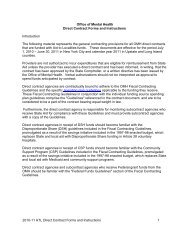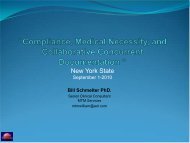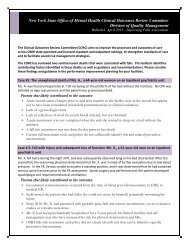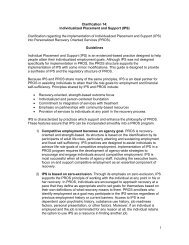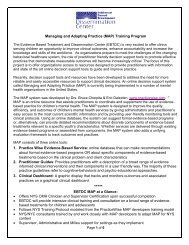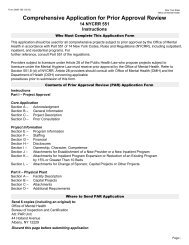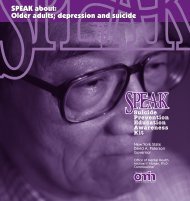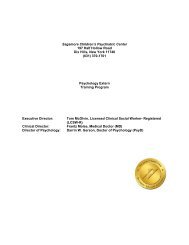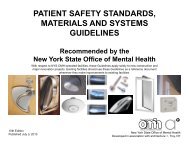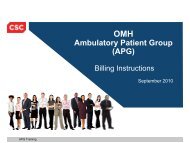Download - New York State Office of Mental Health
Download - New York State Office of Mental Health
Download - New York State Office of Mental Health
Create successful ePaper yourself
Turn your PDF publications into a flip-book with our unique Google optimized e-Paper software.
Saving Lives in <strong>New</strong> <strong>York</strong> Volume 2: Approaches and Special Populations<br />
YOUTH SUICIDE RISK AND INTERVENTIONS<br />
all suicide rate, as well as firearm-related suicides (e.g.,<br />
Boor and Bair, 1990; Carrington and Moyer, 1994; Lester<br />
and Murrell, 1980, 1986; L<strong>of</strong>tin et al., 1991; Med<strong>of</strong>f and<br />
Magaddino, 1983), while others have found no overall<br />
effect (Rich et al., 1990) or equivocal results (Cantor and<br />
Slater, 1995; Cummings et al., 1997; Sloan et al., 1990).<br />
The equivocal findings largely reflected age-specific effects<br />
(Cantor and Slater, 1995; Sloan et al., 1990), in that<br />
restrictive gun laws had a greater impact on adolescents<br />
and young adults. Unfortunately, recent legislative initiatives<br />
such as the 1994 Brady Bill, which imposes a delay<br />
in purchasing a handgun, did not find promising results:<br />
A comparison <strong>of</strong> states that did and did not pass Brady<br />
Bill statutes showed no impact on the proportion <strong>of</strong> suicides<br />
attributable to firearms except in elderly males<br />
(Ludwig and Cook, 2000).<br />
Less controversial means-restriction measures in the<br />
United <strong>State</strong>s involve education to parents <strong>of</strong> high-risk<br />
youths. Kruesi and colleagues (1999) demonstrated that<br />
injury prevention education in emergency rooms led parents<br />
to take new action to limit access to lethal means,<br />
such as locking up their firearms. Unfortunately, Brent<br />
et al. (2000) found that parents <strong>of</strong> depressed adolescents<br />
were frequently noncompliant with recommendations to<br />
remove firearms from the home.<br />
A common concern is that method substitution will<br />
occur following a means-restriction program. Some evidence<br />
<strong>of</strong> method substitution exists (Lester and Leenaars,<br />
1993; Lester and Murrell, 1982; Rich et al., 1990); however,<br />
method substitution does not appear to be an inevitable<br />
reaction to firearms restriction (Cantor and Slater, 1995;<br />
Carrington and Moyer, 1994; Lester and Murrell, 1986;<br />
L<strong>of</strong>tin et al., 1991). Moreover, even if some individuals<br />
do substitute other methods, the chances <strong>of</strong> survival may<br />
be greater if the new methods are less lethal (Cantor and<br />
Baume, 1998).<br />
Media Education. Given the substantial evidence for<br />
suicide contagion, a recommended suicide prevention strategy<br />
involves educating media pr<strong>of</strong>essionals about contagion,<br />
in order to yield stories that minimize harm. Moreover,<br />
the media’s positive role in educating the public about risks<br />
for suicide and shaping attitudes about suicide should be<br />
encouraged.<br />
A set <strong>of</strong> recommendations on reporting <strong>of</strong> suicide were<br />
recently developed by an international workgroup headed<br />
by the American Foundation for Suicide Prevention and<br />
the Annenberg School <strong>of</strong> Communication and Public<br />
Policy (American Foundation for Suicide Prevention,<br />
2001). Guidelines for media reporting now exist in several<br />
countries. Recommendations generally include descriptions<br />
<strong>of</strong> factors that should be avoided because they are<br />
more likely to induce contagion (e.g., front page coverage)<br />
and suggestions on how to increase the usefulness <strong>of</strong><br />
the report (e.g., describing treatment resources).<br />
Following the implementation <strong>of</strong> media guidelines in<br />
Austria, suicide rates declined 7% in the first year, nearly<br />
20% in the 4-year follow-up period, and subway suicides<br />
(a particular focus <strong>of</strong> the media guidelines) decreased by<br />
75% (Etzersdorfer et al., 1992; Etzersdorfer and Sonneck,<br />
1998; Sonneck et al., 1994). In Switzerland, Michel et al.<br />
(2000) found that following the implementation <strong>of</strong> guidelines,<br />
the number <strong>of</strong> articles increased but they were significantly<br />
shorter and less likely to be on the front page;<br />
headlines, pictures, and text were less sensational; there<br />
were relatively fewer articles with pictures; and their overall<br />
“Imitation Risk Scores” were lower. Given the successful<br />
strategy <strong>of</strong> engaging the media in Austria and<br />
Switzerland, efforts to systematically disseminate and<br />
evaluate media recommendations in the United <strong>State</strong>s<br />
are recommended.<br />
<strong>Health</strong> Care-Based Prevention Programs<br />
Educational/Training Programs for Primary Care Physicians<br />
and Pediatricians. The need for training primary care physicians<br />
and pediatricians in the United <strong>State</strong>s is highlighted<br />
by the finding that while 72% <strong>of</strong> 600 family physicians<br />
and pediatricians in North Carolina had prescribed a SSRI<br />
for a child or adolescent patient, only 8% said they had<br />
received adequate training in the treatment <strong>of</strong> childhood<br />
depression and only 16% reported that they felt comfortable<br />
treating children for depression (Voelker, 1999).<br />
Furthermore, although many suicidal young people (15–34<br />
years) seek general medical care in the month preceding<br />
their suicidal behavior (Pfaff et al., 1999), fewer than half<br />
<strong>of</strong> physicians surveyed reported that they routinely screen<br />
their patients for suicide risk (Frankenfield et al., 2000).<br />
Pfaff et al. (2001) demonstrated that after a 1-day training<br />
workshop for 23 primary care physicians in Australia,<br />
inquiry about suicidal ideation increased by 32.5% and<br />
identification <strong>of</strong> suicidal patients increased by 130%,<br />
although no significant change in patient management<br />
resulted and referrals <strong>of</strong> suicidal youths to mental health<br />
specialists remained low. The effectiveness <strong>of</strong> educational<br />
programs for health care pr<strong>of</strong>essionals has also been demonstrated<br />
by the Gotland study (Rutz et al., 1992). After the<br />
implementation <strong>of</strong> an intensive postgraduate training pro-<br />
J. AM. ACAD. CHILD ADOLESC. PSYCHIATRY, 42:4, APRIL 2003 397<br />
56 Adolescents (Appendix)



